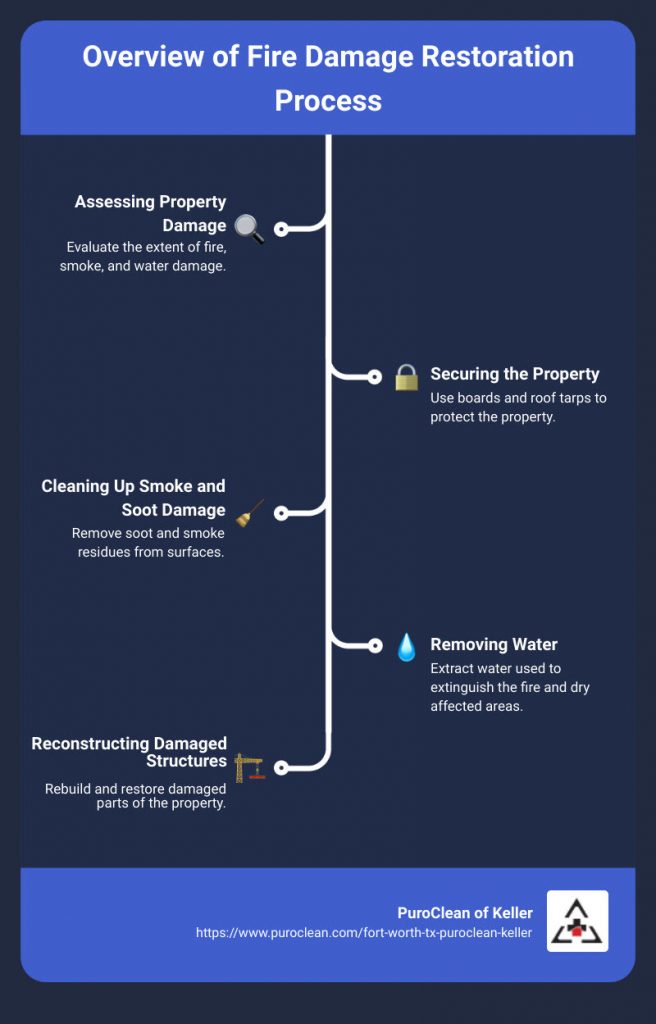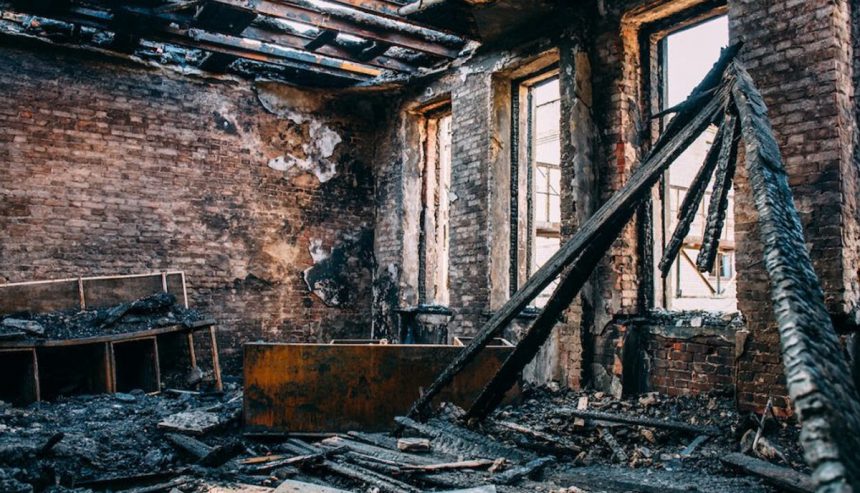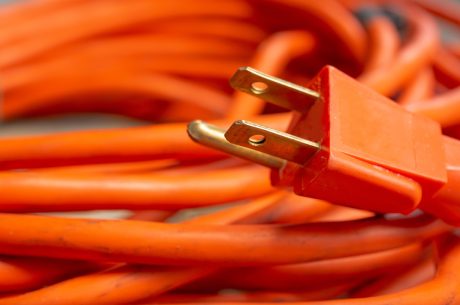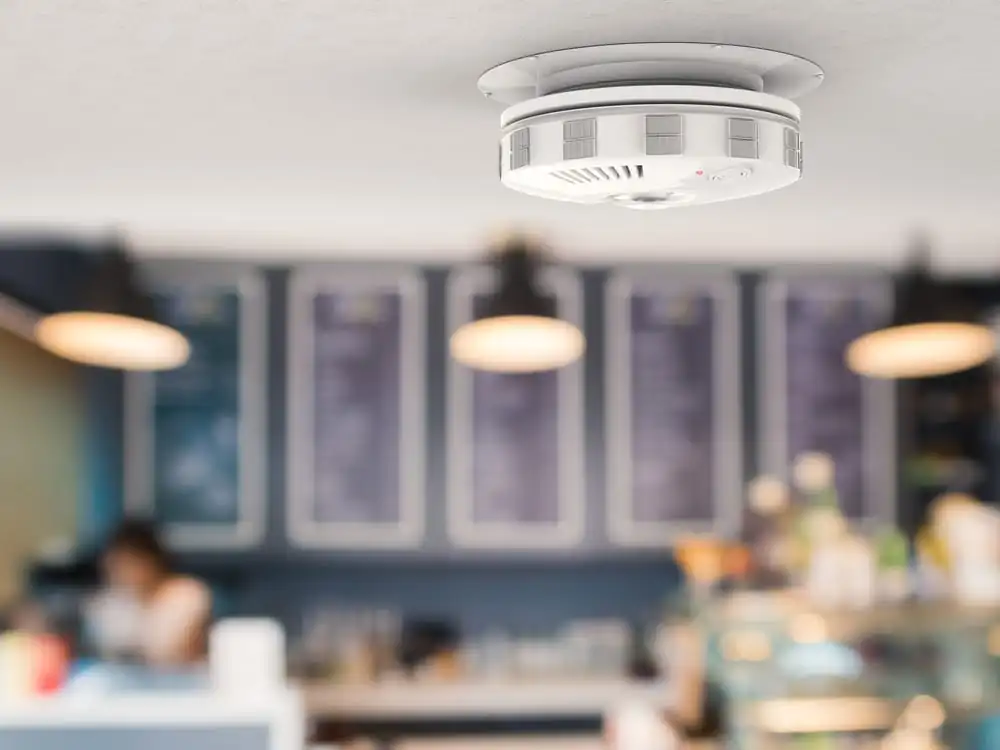
Image Alt Text: fire damage – what is fire damage restoration
What is fire damage restoration? At its core, fire damage restoration involves assessing the damage caused by fire and taking action to restore the property to its pre-fire condition. Here’s a quick overview of what this process includes:
- Assessing property damage
- Securing the property with boards and roof tarps
- Cleaning up smoke and soot damage
- Removing water used to extinguish the fire
- Reconstructing damaged structures
Fires can be devastating, leaving behind not just charred debris but also smoke and water damage that complicates the recovery process. Professional fire restoration aims to mitigate these damages as quickly and efficiently as possible.
At PuroClean of Keller, we specialize in comprehensive fire damage restoration services. Our experienced team understands the intricacies of fire damage and employs proven techniques to restore your home or business to its original state.
Hello, I’m Jiri Smetana. Born to Czechoslovakian parents who fled communism, I grew up dedicated to hard work and innovation. With backgrounds in both chemical engineering and law, my journey led me to establish PuroClean, especially driven by my passion for restoration and the science of drying. Stay with me as we dive deeper into what fire damage restoration entails.

Image Alt Text: Overview of Fire Damage Restoration Process – what is fire damage restoration infographic infographic-line-5-steps
What is Fire Damage Restoration?
Fire damage restoration is the process of returning a fire and smoke-damaged property to its pre-loss condition. This involves a comprehensive approach that addresses not only the visible damage but also the hidden issues that could cause future problems.
Definition:
Fire damage restoration is more than just cleaning up the charred remains. It involves assessing the damage, securing the property, removing water, cleaning soot and smoke, and finally, repairing and rebuilding the affected areas.
Pre-loss Condition:
The goal is to restore the property to its pre-loss condition. This means making it look and feel as if the fire never happened. Achieving this involves several steps, including structural repairs and thorough cleaning.
Smoke Damage:
Smoke damage can be deceptive. It not only discolors walls and ceilings but also leaves behind a persistent odor that can be harmful. Smoke particles can infiltrate carpets, furniture, and even ductwork, making it essential to clean every nook and cranny.
“Byproducts of the smoke and soot can easily lead to respiratory issues as well as irritation of the skin and eyes,” notes a .
Water Damage:
Water damage often accompanies fire damage, as firefighters use water to extinguish the blaze. This water can seep into floors, walls, and other structural elements, leading to mold growth and further weakening the structure. Quick water removal and drying are crucial to prevent additional damage.
Structural Repairs:
Structural repairs are a significant part of the restoration process. This can include anything from replacing damaged drywall and flooring to rebuilding entire sections of the property. The aim is to ensure the building is safe and structurally sound.
In summary, fire damage restoration is a multi-step process that involves assessing the damage, securing the property, removing water, cleaning soot and smoke, and making necessary structural repairs. The ultimate goal is to restore the property to its pre-loss condition, making it safe and livable once again.
Next, let’s dive into the detailed steps involved in the fire damage restoration process.
Steps in the Fire Damage Restoration Process
Fire damage restoration is a comprehensive process that ensures your property is safe and livable again. Here are the key steps involved:
1. Assessment of Damage
The first step is a thorough damage assessment. Professionals inspect the property to determine the extent of fire, smoke, and water damage. They create a detailed report and provide a cost estimate for the restoration.
2. Securing the Property
To prevent further damage and ensure safety, the property is secured. This involves:
- Boarding up windows and doors to prevent unauthorized entry.
- Installing roof tarps to protect against weather damage.
- Fencing off hazardous areas to keep people safe.
3. Water Extraction and Drying
Water used to extinguish the fire can cause significant damage. Quick water removal is crucial to prevent mold growth and structural weakening. This step involves:
- Extracting standing water using pumps and vacuums.
- Dehumidifying the area to remove moisture from the air.
- Drying out affected materials to stop mold and mildew.
4. Debris Removal and Demolition
Next, any debris and irreparably damaged materials are removed. This controlled demolition helps clear the way for restoration. It includes:
- Removing charred furniture and belongings.
- Demolishing unsafe structures like damaged walls or ceilings.
- Handling hazardous materials with care to ensure safety.
5. Cleaning and Decontamination
Cleaning up after a fire involves more than just removing soot. It also includes:
- Soot and ash removal from surfaces and air ducts.
- Eliminating smoke odors using specialized equipment.
- Applying antimicrobial treatments to prevent mold and bacteria growth.
6. Reconstruction and Repairs
Finally, the property is rebuilt to its pre-loss condition. This can include:
- Rebuilding structural elements like walls and roofs.
- Restoring interiors such as flooring and paint.
- Replacing damaged furniture and fixtures to make the space livable again.
Each of these steps is crucial to ensure the property is safe, clean, and restored to its original state. The process can be lengthy, but it’s essential for making your home or business safe and comfortable once more.
Next, we’ll explore the common causes of fire damage and how to prevent them.
1. Assessment of Damage
Before restoration can begin, a thorough assessment of damage is critical. This initial step helps determine the scope of work needed to restore the property to its pre-loss condition. Here’s what happens during the assessment phase:
Safety Inspection
First, a licensed authority must declare the property safe to enter. Without this clearance, restoration professionals risk injury by entering an unstable structure.
Safety checks include:
- Evaluating structural integrity.
- Checking for hazardous materials like asbestos or lead.
- Ensuring there are no immediate dangers, such as exposed wiring or gas leaks.
Damage Assessment
Once the property is deemed safe, the restoration contractor will conduct a comprehensive damage assessment. This involves examining how far flames, smoke, and water have penetrated the structure.
Key focus areas:
- Structural Damage: Identifying charred, blackened, or disintegrated parts of the building.
- Heat Damage: Assessing materials that have melted or warped due to prolonged heat exposure.
- Water Damage: Evaluating water intrusion from firefighting efforts, which can lead to mold growth and structural weakening.
- Smoke Damage: Checking for discoloration, corrosion, and pervasive odors that can affect air quality and health.
Cost Estimate
After the damage assessment, the contractor will provide a detailed cost estimate. This includes the scope of work, materials needed, and the estimated timeline for completion.
Components of the cost estimate:
- Labor and Material Costs: Detailed breakdown of what it will take to restore damaged areas.
- Timeline: Estimated duration of the restoration process.
- Additional Services: Costs for specialized services like mold remediation, asbestos removal, and contents cleaning.
With this information, property owners can make informed decisions and coordinate with their insurance companies to cover the necessary expenses.
Next, we’ll discuss how to secure the property to prevent further damage.
2. Securing the Property
After assessing the damage, the next crucial step in fire damage restoration is securing the property. This ensures the site is safe and prevents any further damage or unauthorized access. Here are the main methods used:
Board-Up
Boarding up the structure is essential to keep out the elements and unauthorized individuals. This involves covering broken windows, doors, and other openings with plywood. Proper board-up techniques use 3/8″ plywood and 2x4s bolted from inside the dwelling. This helps to stabilize the structure and prevent further weather-related damage.
Example: After a recent fire in a local neighborhood, the PuroClean of Keller team quickly boarded up all windows and doors, preventing rain from causing additional water damage.
Fencing
Installing a fence around the property adds an extra layer of security. This helps to deter trespassers and keeps curious onlookers at a safe distance. Fencing also helps to protect any remaining valuable items within the property.
Fact: According to the National Fire Protection Association, roughly 375,000 homes catch fire each year. Securing these properties with fencing is a standard practice to ensure safety and security during the restoration process.
Roof Tarps
If the roof is damaged, installing roof tarps is vital to protect the interior from rain and debris. Roof tarps are heavy-duty and can cover large areas, providing a temporary but effective barrier against the elements.
Case Study: In one restoration project, PuroClean of Keller used roof tarps to cover a severely damaged section of a home’s roof. This prevented rain from entering the structure and allowed the team to focus on other critical restoration tasks.
By securing the property through board-up, fencing, and roof tarps, the restoration team can prevent further damage and create a safe environment for the subsequent steps in the fire damage restoration process.
Next, we’ll delve into the importance of water extraction and drying in the restoration process.
3. Water Extraction and Drying
After a fire, water damage often follows due to firefighting efforts. Removing this water quickly is crucial to prevent further damage and mold growth.
Water Removal
First, the restoration team uses specialized equipment to extract standing water from the affected areas. This includes powerful pumps and vacuums designed to handle large volumes of water efficiently. The faster the water is removed, the less chance it has to cause additional damage to your property.
Example: In one case, a home experienced severe water damage after a fire. PuroClean of Keller arrived promptly and used industrial-grade pumps to remove over 1,000 gallons of water within hours, preventing extensive mold growth and structural weakening.
Dehumidifying
Once the standing water is gone, the next step is dehumidifying the area. This involves using dehumidifiers to remove moisture from the air and materials. High humidity levels can cause secondary damage like mold growth and wood warping.
Fact: According to the Institute of Inspection, Cleaning, and Restoration Certification (IICRC), proper dehumidification is essential to bring moisture levels back to normal and prevent mold.
Mold Prevention
Mold can start growing within 24 to 48 hours after water exposure. To prevent this, the team applies antimicrobial treatments to affected areas. These treatments kill mold spores and stop them from spreading.
Quote: “Mold prevention is a critical step that often gets overlooked but can save a lot of trouble down the road,” says a certified technician from PuroClean of Keller.
By focusing on water removal, dehumidifying, and mold prevention, the restoration team ensures that your property is thoroughly dried and safe from further damage.
Next, we’ll discuss the crucial steps of debris removal and demolition in the fire damage restoration process.
4. Debris Removal and Demolition
After water removal and drying, the next step in the fire damage restoration process is debris removal and controlled demolition. This stage is essential for clearing the way for rebuilding and ensuring the safety of the property.
Debris Removal
Debris removal involves clearing out all the burnt and damaged materials from the property. This includes:
- Furniture and appliances: Anything that can’t be salvaged must be disposed of properly.
- Building materials: Charred wood, melted plastics, and damaged drywall need to be removed.
- Personal items: Belongings that are beyond repair are cataloged and discarded.
Clearing debris is not just about cleanliness; it’s about safety. Burnt materials can be hazardous, and clearing them helps to prevent injuries and further damage.
Controlled Demolition
Controlled demolition is the careful tearing down of parts of the structure that are too damaged to be repaired. This might include:
- Walls and ceilings: Sections that are structurally unsound.
- Flooring: Areas that have been severely compromised by fire or water.
- Roof sections: Parts that can’t be protected with tarps and need to be rebuilt.
Controlled demolition ensures that only the necessary parts of the structure are removed, minimizing disruption and focusing efforts on rebuilding.
Hazardous Materials
During debris removal and demolition, it’s crucial to handle hazardous materials safely. Fires can release harmful substances, including:
- Asbestos: Often found in older buildings.
- Lead: Present in old paint and pipes.
- Toxic chemicals: From burnt household items and building materials.
Professionals use specialized equipment and follow strict safety protocols to handle and dispose of these materials, ensuring the safety of everyone involved.
By efficiently removing debris and conducting controlled demolition, the restoration team clears the way for the next steps in the process. This sets the stage for cleaning, decontamination, and ultimately, rebuilding your property.
Next, we’ll dive into the detailed steps involved in cleaning and decontamination.
5. Cleaning and Decontamination
After removing debris and completing controlled demolition, the next critical step in fire damage restoration is cleaning and decontamination. This process focuses on soot removal, eliminating smoke odors, and applying antimicrobial treatments to ensure your home is safe and livable again.
Soot Removal
Soot is a black, powdery substance created by incomplete burning of materials. It’s not just unsightly; it can also be harmful. Soot is acidic and can corrode building materials and personal belongings if not removed promptly.
Key steps in soot removal:
- Identify affected areas: Soot can settle on walls, ceilings, furniture, and even inside HVAC systems.
- Vacuum with HEPA filters: High-Efficiency Particulate Air (HEPA) vacuums are used to trap tiny soot particles without redistributing them into the air.
- Dry cleaning sponges: These special sponges are used on surfaces like walls and ceilings to lift soot without smearing.
- Chemical cleaners: For tougher soot stains, professional-grade cleaners are applied.
Smoke Odor Removal
Smoke odor can linger long after the fire is out, making your home uncomfortable. To effectively remove smoke odor, professionals use advanced techniques and equipment.
Common methods for smoke odor removal:
- Ozone treatments: Ozone generators release ozone molecules that neutralize smoke odors.
- Thermal fogging: This method uses a deodorizing fog to penetrate deep into materials and neutralize odors at the source.
- Air scrubbers: These devices use HEPA filters to remove smoke particles from the air, improving indoor air quality.
Antimicrobial Treatments
Fires often result in water damage from firefighting efforts, creating a breeding ground for mold and bacteria. To prevent these health hazards, antimicrobial treatments are applied.
Steps in antimicrobial treatment:
- Identify areas with water damage: This includes walls, floors, and any porous materials.
- Apply antimicrobial agents: These chemicals inhibit the growth of mold and bacteria.
- Monitor moisture levels: Using moisture meters, professionals ensure that the treated areas remain dry and safe.
This comprehensive cleaning and decontamination process is essential for restoring your home to a safe and healthy condition. By addressing soot, smoke odors, and potential microbial growth, professionals make sure that your living space is truly restored.
Next, we’ll explore the final steps in the fire damage restoration process: reconstruction and repairs.
6. Reconstruction and Repairs
Once the property is clean and decontaminated, the next step is reconstruction and repairs. This phase aims to restore your home to its pre-loss condition, addressing everything from structural repairs to interior restoration.
Rebuilding
Rebuilding involves major structural work. If the fire has compromised the integrity of the building, professionals will need to rebuild affected areas. This can include:
- Roof repairs: Fixing or replacing damaged sections.
- Wall reconstruction: Rebuilding walls that have been destroyed or heavily damaged.
- Flooring: Installing new floors if the original ones are beyond repair.
Structural Repairs
Structural repairs ensure that your home is safe and sound. Experts will inspect the building for any hidden damages that might not be visible initially. This can involve:
- Foundation checks: Ensuring the base of your home is stable.
- Framing repairs: Fixing or replacing wooden or metal frames that support the structure.
- Electrical and plumbing work: Replacing damaged wiring and pipes to make sure everything is up to code.
Interior Restoration
Interior restoration focuses on bringing the inside of your home back to life. This includes:
- Painting and drywall: Repainting walls and replacing drywall to erase any signs of fire damage.
- Cabinetry and fixtures: Installing new cabinets, sinks, and other fixtures that were damaged.
- Flooring and carpeting: Laying down new carpets or floors to replace those that were ruined.
A comprehensive reconstruction and repair process ensures that your home not only looks as good as new but is also safe and functional.
Next, we’ll discuss the common causes of fire damage and how to prevent them.
Common Causes of Fire Damage
Understanding what causes fires can help you prevent them. Here are some of the most common culprits:
Cooking Equipment
Cooking is the leading cause of house fires. Grease fires can start in seconds if left unattended. Even a small distraction can lead to a disaster.
Case in point: A family in Texas left a pan of oil on the stove while they answered a phone call. Within minutes, the kitchen was ablaze, causing extensive damage and requiring months of restoration work.
Home Heaters
Especially in winter, home heaters are a common fire hazard. Faulty wiring or placing heaters too close to flammable materials like curtains can ignite a fire. Always keep heaters away from anything that can burn and inspect them regularly.
Smoking and Candles
Smoking and candles are another significant cause of house fires. A single ash or an unattended candle can set flammable items, like curtains or bedding, on fire.
Real-life example: In one instance, a candle left burning in a living room tipped over and ignited a nearby curtain. The result was a fire that caused severe smoke damage throughout the house.
Chemicals
Certain household chemicals can also be fire hazards. Products like motor oil or cleaning liquids can ignite under specific conditions. Always store these items properly and away from heat sources.
Statistics: According to the National Fire Protection Association, household chemicals are responsible for a notable percentage of home fires each year.
By knowing these common causes, you can take steps to make your home safer. Next, we’ll explore the different types of fire damage you might encounter.
Types of Fire Damage
When a fire occurs, it can cause several types of damage to your property. Understanding these types can help you better grasp the restoration process. Here are the main categories:
Fire Damage
Fire damage is the most obvious and immediate result of a fire. It includes:
- Charring: This is when materials are burned on the surface, often turning black and brittle. For instance, wooden beams may become charred and lose their structural integrity.
- Blackening: Soot and ash can cover surfaces, leading to blackened walls, ceilings, and furniture. This often requires extensive cleaning or replacement.
- Disintegration: Prolonged exposure to flames can cause materials to disintegrate completely. Items like fabric, paper, and some plastics may be irreparably destroyed.
Water Damage
Ironically, putting out a fire often results in water damage. This happens because firefighters use large amounts of water to extinguish flames. Key issues include:
- Water Intrusion: Water can seep into walls, floors, and furniture. This can weaken the structural integrity of your home.
- Mold Growth: If water is not dried quickly, mold can start to grow within 24-48 hours. Mold can cause health issues and further damage to your property.
- Structural Weakening: Water can weaken wooden structures and cause metal parts to rust, making your home unsafe.
Smoke Damage
Smoke damage is often less visible but can be just as harmful. It includes:
- Discoloration: Smoke can cause yellowing or staining on walls, ceilings, and other surfaces.
- Odor: Smoke leaves a lingering smell that can be difficult to remove. This odor can penetrate carpets, upholstery, and even walls.
- Corrosion: Smoke contains acidic compounds that can corrode metal surfaces, leading to rust and deterioration.
Each type of damage requires specific methods for restoration. It’s crucial to address all these aspects to fully restore your home.
Next, we will dive into the steps involved in the fire damage restoration process.
Frequently Asked Questions about Fire Damage Restoration
What is the meaning of fire restoration?
Fire restoration is the process of cleaning, repairing, and restoring a property that has been damaged by fire. The goal is to return the property to its pre-loss condition, meaning it looks and functions as it did before the fire. This includes addressing not only the physical damage caused by the flames but also the smoke and water damage that often accompanies firefighting efforts.
How do you restore after a fire?
Restoring a property after a fire involves several key steps:
- Assessment of Damage: Professionals assess the extent of fire, smoke, and water damage to create a restoration plan.
- Securing the Property: This may involve boarding up windows, installing roof tarps, and setting up fencing to prevent further damage and unauthorized entry.
- Water Extraction and Drying: Any water used to extinguish the fire is removed, and the property is dried to prevent mold growth.
- Debris Removal and Demolition: Damaged materials are safely removed, and any hazardous substances like asbestos are handled appropriately.
- Cleaning and Decontamination: Soot and smoke odors are eliminated using specialized equipment and treatments.
- Reconstruction and Repairs: Finally, the property is rebuilt and restored, including structural repairs and interior restoration.
What is considered fire damage?
Fire damage encompasses several types of harm to a property:
- Physical Damage: This includes charring, blackening, and disintegration of materials directly affected by the fire.
- Smoke Damage: Smoke can cause discoloration, leave a persistent odor, and corrode metal surfaces due to its acidic compounds.
- Water Damage: Water used to extinguish the fire can lead to structural weakening and mold growth if not properly managed.
Fire restoration professionals use specialized techniques and equipment to address all these types of damage, ensuring the property is safe and livable once again.
Next, we will dive into the steps involved in the fire damage restoration process.
Conclusion
At PuroClean of Keller, we understand that dealing with fire damage can be overwhelming. That’s why we’re committed to providing comprehensive fire damage restoration services to help you get back on your feet.
Our 24/7 emergency service ensures that we’re always ready to respond when disaster strikes. We know that fires don’t wait for convenient times, so neither do we. Our team is available around the clock to assess the damage and begin the restoration process immediately.
We use advanced technology to tackle even the most challenging restoration projects. From state-of-the-art water extraction equipment to specialized tools for smoke and soot removal, we have the resources needed to restore your property to its pre-loss condition. Our techniques are designed to be thorough and efficient, minimizing further damage and speeding up the recovery process.
Our team consists of certified technicians who are experts in fire damage restoration. They are trained to handle all aspects of the restoration process, from initial assessment to final repairs. Their expertise ensures that every job is done right, providing you with peace of mind during a difficult time.
If you need fire damage restoration services, don’t hesitate to contact us. We’re here to help you restore your home and your life after the fire.




 PuroClean of Keller
PuroClean of Keller